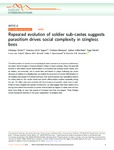Use este identificador para citar ou linkar para este item:
http://www.alice.cnptia.embrapa.br/alice/handle/doc/1065560Registro completo de metadados
| Campo DC | Valor | Idioma |
|---|---|---|
| dc.contributor.author | GRÜTER, C. | pt_BR |
| dc.contributor.author | SEGERS, F. H. I. D. | pt_BR |
| dc.contributor.author | MENEZES, C. | pt_BR |
| dc.contributor.author | VOLLET-NETO, A. | pt_BR |
| dc.contributor.author | FALCÓN, T. | pt_BR |
| dc.contributor.author | ZUBEN, L. von | pt_BR |
| dc.contributor.author | BITONDI, M. M. G. | pt_BR |
| dc.contributor.author | NASCIMENTO, F. S. | pt_BR |
| dc.contributor.author | ALMEIDA, E. A. B. | pt_BR |
| dc.date.accessioned | 2017-02-24T11:11:11Z | pt_BR |
| dc.date.available | 2017-02-24T11:11:11Z | pt_BR |
| dc.date.created | 2017-02-24 | pt_BR |
| dc.date.issued | 2017 | pt_BR |
| dc.identifier.citation | Nature Communications, v. 8, art. n. 4, 23 Feb. 2017. | pt_BR |
| dc.identifier.uri | http://www.alice.cnptia.embrapa.br/alice/handle/doc/1065560 | pt_BR |
| dc.description | The differentiation of workers into morphological castes represents an important evolutionary innovation that is thought to improve division of labor in insect societies. Given the potential benefits of task-related worker differentiation, it is puzzling that physical worker castes, such as soldiers, are extremely rare in social bees and absent in wasps. Following the recent discovery of soldiers in a stingless bee, we studied the occurrence of worker differentiation in 28 stingless bee species from Brazil and found that several species have specialized soldiers for colony defence. Our results reveal that worker differentiation evolved repeatedly during the last ~ 25 million years and coincided with the emergence of parasitic robber bees, a major threat to many stingless bee species. Furthermore, our data suggest that these robbers are a driving force behind the evolution of worker differentiation as targets of robber bees are four times more likely to have nest guards of increased size than non-targets. These findings reveal unexpected diversity in the social organization of stingless bees. | pt_BR |
| dc.language.iso | eng | eng |
| dc.rights | openAccess | eng |
| dc.subject | Evolução | pt_BR |
| dc.title | Repeated evolution of soldier sub-castes suggests parasitism drives social complexity in stingless bees. | pt_BR |
| dc.type | Artigo de periódico | pt_BR |
| dc.date.updated | 2017-04-03T11:11:11Z | pt_BR |
| dc.subject.thesagro | Abelha | pt_BR |
| dc.subject.thesagro | Parasitismo | pt_BR |
| riaa.ainfo.id | 1065560 | pt_BR |
| riaa.ainfo.lastupdate | 2017-04-03 | pt_BR |
| dc.identifier.doi | 10.1038/s41467-016-0012-y | pt_BR |
| dc.contributor.institution | Christoph Grüter, USP/Johannes Gutenberg University Mainz; Francisca H. I. D. Segers, USP/Institute of Zoology, Johannes Gutenberg University Mainz; CRISTIANO MENEZES, CPATU; Ayrton Vollet-Neto, USP; Tiago Falcón, USP; Lucas von Zuben, USP; Márcia M. G. Bitondi, USP; Fabio S. Nascimento, USP; Eduardo A. B. Almeida, USP. | pt_BR |
| Aparece nas coleções: | Artigo em periódico indexado (CPATU)  | |
Arquivos associados a este item:
| Arquivo | Descrição | Tamanho | Formato | |
|---|---|---|---|---|
| NatureCristiano.pdf | 595.24 kB | Adobe PDF |  Visualizar/Abrir |









